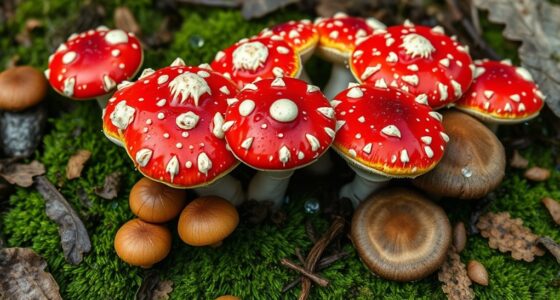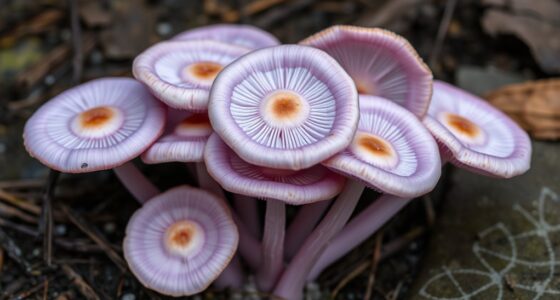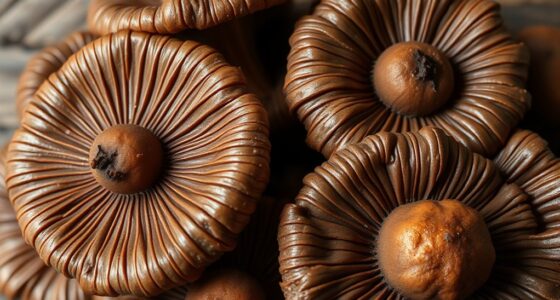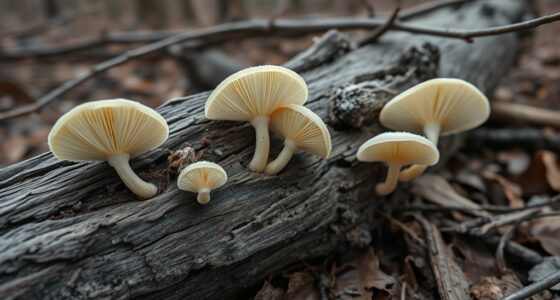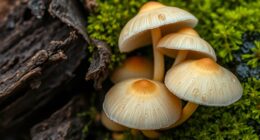When teaching children about safe mushroom foraging, set clear boundaries and supervise closely to keep them within safe areas. Teach identification skills by focusing on key features and using simple guides, emphasizing that no mushroom is worth risking their health. Create a learning-friendly environment by turning safety into fun games and encouraging questions. Fostering curiosity with caution helps kids develop confidence; if you want to explore more ways to keep your little foragers safe, keep going.
Key Takeaways
- Teach children to recognize and differentiate between edible and toxic fungi using simple, reliable identification guides.
- Establish clear boundaries and supervise children closely to prevent wandering into unsafe areas.
- Use engaging safety routines as learning games to promote awareness and build confidence in cautious foraging.
- Ensure children wear appropriate clothing and protective gear, like gloves, during mushroom hunting.
- Reinforce that when in doubt, it’s safest to leave the fungus untouched and seek adult guidance.

Foraging for fungi with children can be a rewarding outdoor activity, but safety should always come first. As you explore the woods together, it’s essential to develop strong identification skills that will keep everyone safe and foster a sense of liberation through discovery. When you teach children how to recognize edible fungi versus toxic ones, you’re empowering them to connect with nature responsibly. This knowledge transforms foraging from a simple walk into a meaningful adventure, where curiosity and caution go hand in hand. Remember, outdoor safety isn’t just about avoiding danger; it’s about cultivating confidence and awareness that lasts a lifetime.
Start by making identification skills your top priority. Show children how to observe details like cap shape, color, gills, and stem features. Use simple, memorable guides or apps designed for beginners, and emphasize the importance of always double-checking before touching or tasting anything. If there’s any doubt about a fungus’s identity, the safest choice is to leave it untouched. Reinforce that no fungus is worth risking health for, and that it’s better to be cautious than adventurous in this context. Properly understanding the differences between edible and toxic fungi is crucial for safe foraging. By practicing these skills together, you create a shared sense of responsibility and respect for nature’s power.
Prioritize identification skills, double-check fungi, and always err on the side of caution to ensure safe foraging with children.
Outdoor safety involves more than just mushroom recognition. Establish clear boundaries in your foraging area, so children learn where it’s safe to go and where they should avoid. Teach them to stay close and follow your lead, never wandering off on their own. Equip everyone with appropriate clothing and tools—like gloves and baskets—to handle plants safely and avoid skin contact with unknown fungi. Keep a first aid kit nearby, just in case, and discuss what to do if someone feels unwell or accidentally ingests a fungus. These routines build a secure environment that encourages children to explore confidently without feeling restricted.
Make safety a natural part of the experience by turning it into a game of observation and learning. Let children help you identify fungi, ask questions, and share their discoveries. Celebrate their successes and gently correct mistakes, fostering an atmosphere of liberation where curiosity is celebrated but caution is always maintained. Cultivating these skills and habits not only protects everyone but also nurtures independent thinkers who respect the wild. When safety becomes second nature, your foraging adventures become more than just fun—they become moments of empowerment and connection, inspiring a lifelong appreciation for nature’s wonders.
Frequently Asked Questions
How Can I Identify Edible Versus Poisonous Mushrooms Accurately?
To identify edible versus poisonous mushrooms accurately, focus on mushroom identification by examining features like cap shape, gill structure, and stem. Use edible mushroom tips from reliable guides or experts to avoid misidentification. Always double-check your findings, and never consume a mushroom unless you’re 100% sure it’s safe. Remember, when in doubt, it’s best to leave it out—your safety comes first during foraging adventures.
What Age Is Appropriate for Children to Start Mushroom Foraging?
You can start mushroom foraging with children around age 8 or older, when they can grasp basic identification and follow safety rules. While their curiosity is boundless, always supervise closely and teach beginner techniques to avoid hazards. Think of it as a journey of discovery, where freedom to explore meets responsible guidance. As they learn to respect nature, your child’s confidence and understanding grow, making the experience both liberating and safe.
Are There Any Legal Restrictions on Mushroom Foraging in Parks?
You should verify park regulations before foraging, as many parks restrict mushroom collection to protect natural habitats. Typically, permitted areas are designated, and collecting mushrooms without permission can lead to fines or other penalties. To enjoy your foraging adventure freely, always verify which areas allow it. Respect the rules to preserve the environment and ensure you can continue exploring freely without risking legal trouble or damaging the ecosystem.
How Do I Teach Children About Mushroom Toxins Safely?
To teach children about mushroom safety, make education engaging and hands-on. Show them how to identify safe mushrooms and explain the dangers of toxins clearly. Use simple language and visual aids to emphasize that some mushrooms look harmless but are deadly. Encourage curiosity while instilling respect for nature’s risks. By fostering awareness through child education, you help them confidently enjoy foraging while staying safe from mushroom toxins.
What Should I Do if a Child Ingests a Wild Mushroom?
If a child unknowingly eats a wild mushroom, act quickly to protect their safety and initiate emergency response. Call poison control immediately and seek medical help without delay. Keep the child calm and monitor their condition closely, providing details about the mushroom if possible. Your swift, confident actions can make all the difference, ensuring their well-being and guiding them back to the joy of safe exploration.
Conclusion
Remember, mushroom foraging with children is like walking a tightrope—you must stay alert and cautious. By teaching kids to recognize safe varieties and emphasizing the importance of expert identification, you create a journey filled with discovery, not danger. Keep safety at the forefront, and your outdoor adventure will be a beautiful tapestry woven with curiosity and care. When you approach it with vigilance, the woods become a classroom where both you and your children grow wiser together.



